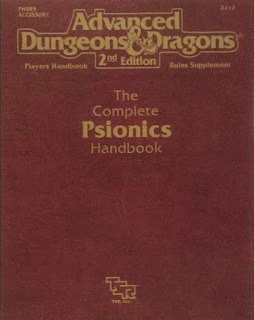Retrospective: The Complete Psionics Handbook
 The Complete series of rules supplements for Advanced Dungeons & Dragons Second Edition was, at the time of its inception at the tail end of the 1980s, a genuine innovation – supplements specifically focused on a particular character class or race and providing new ideas, rules, and options for use with them. Later, thanks in large part to White Wolf's "World of Darkness" games, this type of book would become commonplace in the hobby, but, when the Complete series first appeared, there were few prior examples of these "splatbooks," as they'd become known in the gamer argot.
The Complete series of rules supplements for Advanced Dungeons & Dragons Second Edition was, at the time of its inception at the tail end of the 1980s, a genuine innovation – supplements specifically focused on a particular character class or race and providing new ideas, rules, and options for use with them. Later, thanks in large part to White Wolf's "World of Darkness" games, this type of book would become commonplace in the hobby, but, when the Complete series first appeared, there were few prior examples of these "splatbooks," as they'd become known in the gamer argot.Despite my TSR fanboy proclivities, I never embraced the Complete books. I liked them in principle but was never impressed with their actual content. I also recognized quite early on that their mere existence would likely place a lot of pressure on Dungeon Masters to adopt them, since many players would want access to new options for their characters. Furthermore, I anticipated an inevitable power creep in these options, as each new book in the series tried to outdo its predecessors.Because of this, I didn't consider the Complete books must-buys and, after the first two, intended to avoid them entirely. However, early in 1991, TSR released the fifth book in the series, The Complete Psionics Handbook, and I was sufficiently intrigued that I bought it as soon as I saw a copy. Written by Steve Winter, this 128-page book presents a completely new system for introducing "extraordinary psychic powers" – psionics – into AD&D, with an eye toward making their use clearer and easier to use for both players and DMs. Psionics had been a part of Dungeons & Dragons since the publication of Eldritch Wizardry in 1976. That original version, created in part by Steve Marsh, served as the foundation upon which the AD&D Players Handbook would later build its own expanded version of psionics. Neither version was, in the opinions of many, clear or easy to use, so a revision was definitely needed.
Winter's psionics system took a lot of inspiration from the earlier versions but was nevertheless its own thing. He carried over a lot of the names and concepts found in Eldritch Wizardry and the Players Handbook, like ego whip and tower of iron will, for example, and placed them within a large, better conceived mechanical framework. One of the biggest problems with the earlier systems was that they felt very ad hoc and unbalanced. There was scarcely any attention given to how psionics would work in relation to other aspects of the AD&D rules. By contrast, these concerns seem to have been at the forefront of Winter's mind as he wrote The Complete Psionics Handbook and it shows.
First and foremost, psionics in this book are primarily the purview of a single character class: the psionicist. While it's still possible for members of other classes to possess a "wild talent," that's unusual. By taking this approach, Winter analogizes psionics with spellcasting and indeed could be said to have reimagined psionics as an alternate magic system – the points-based system that so many D&D players had been desiring almost since the game's beginning. One of the advantages of this approach is that it enabled psionicists to operate as just another character class alongside all the "standard" ones rather than being these weird – and potentially overpowered – outliers whose presence was likely to upset a campaign.
Reimagined as members of a new class, psionic characters' powers and abilities are now tied to level, just like all the classes. As a psionicist advances, he gains new psionic disciplines, devotions, sciences, and defense modes, as well as more psionic strength points (PSPs) in pretty much the same way a cleric or a magic-user gains new spells with experience. This is a simple and frankly obvious change that turns psionics into something that's workable even at low levels of play, something that was often not true in previous versions. In additional, all psionic powers are better detailed and described, giving players and DMs a better handle on what they can and cannot do within the game. It's all very well done.
At the time of its release, I had nothing but praise for The Complete Psionics Handbook. It had managed to take a strange edge case within the rules of First Edition AD&D (and OD&D before it) and convert it into a system that I could actually imagine myself using and enjoying. Not only that but I found myself actively thinking of ways I could do so. Winter's version of psionics felt fresh and fun and, above all, playable, a word I'd never have used to describe any previous version of psionics. That's no small feat and one of many reasons why I am ever more convinced that, despite the distaste many show for it in this corner of the hobby, I can't bring myself to say that Second Edition was an unmitigated disaster. If it was capable of fixing psionics, how bad could it be?
Published on October 02, 2024 10:00
No comments have been added yet.
James Maliszewski's Blog
- James Maliszewski's profile
- 3 followers
James Maliszewski isn't a Goodreads Author
(yet),
but they
do have a blog,
so here are some recent posts imported from
their feed.



